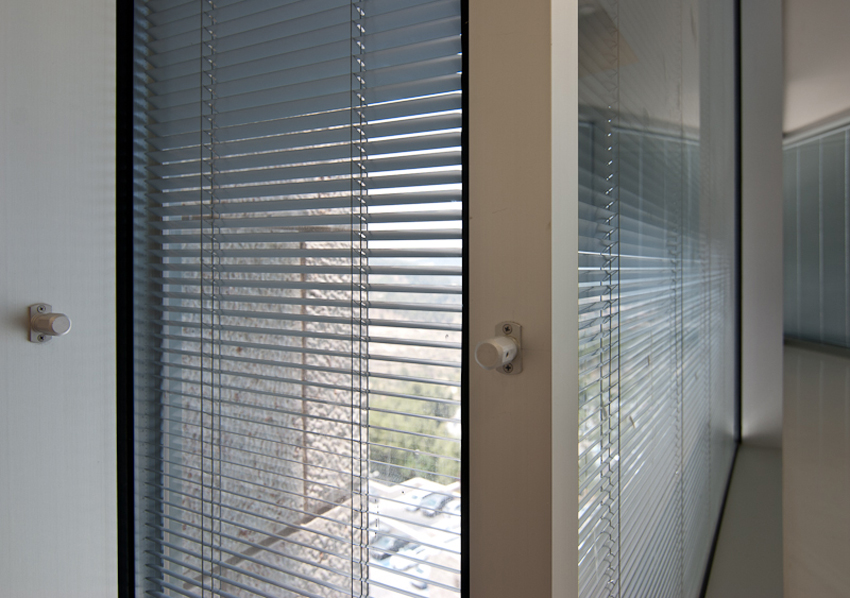Built-In Blinds
Shading Selection
Essentially, the importance of natural light and views is well established, but it is also well known that simply increasing large amounts of glazing on building facades is not necessarily a thermally efficient strategy, nor one that delivers comfortable levels of lighting, not to mention the issue of glare.
“A good work environment that provides sufficient natural daylight and clear transparent views can in turn be a drawback due to glare,” Zobec explains. “This presents a technical design paradox that requires a design balance of daylighting, glare and natural views.”
In fact, HEAD’s report acknowledges that glare has become exacerbated with growth of interactive whiteboards and computer projection in classrooms.
While the study endorses high levels of natural light via large windows, in order to mitigate glare, easy-to-use blinds that don’t cause excessive noise or air flow issues are recommended.

Photo courtesy of Spector-Amisor Architects
Blinds in between the glass deliver easy-to-operate, glare-free daylighting solutions.
In this context, Donovan explains that natural light and clean air, which have been linked to enhanced academic performance, are two factors that BBGs can directly impact.
With conventional blinds, building owners and users must deal with pull cords getting tangled, blinds falling out of line when the door is closed with too much force, and the constant issue of dust gathering on the blinds, the latter of which can jeopardize good IAQ.
This issue is particularly significant amongst office workers, patients in health-care settings, and children in schools with asthma or respiratory health issues, as pollutants and poor IAQ can trigger irritation and inflammation of the lungs.
Just how widespread is this issue? The Centers for Disease Control and Prevention reports that one in 13 people have asthma, amounting to more than 26 million Americans. Among those are 6 million children under the age of 18, with asthma attacks registering as the top reason for missed school days.
A related issue created by dust and pollutants contributing to poor IAQ is the increased possibility of infections in health-care settings. In fact, bacteria is responsible for about 90 percent of hospital-acquired infections (HAI). Particularly in cases where patients are after surgery and their immune systems are low, Healthline reports that HAIs, on average, lead to an additional 6.5 days spent in the hospital and make it five times more likely that patients will be readmitted.
To minimize the risk, health-care professionals recommend a number of strategies, including cleaning surfaces properly, with recommended frequency.
As noted, blinds in between the glass completely eliminate this issue of cleaning dust-gathering blinds and is therefore a common choice in health-care applications.
A case in point is the Hadassah Medical Center’s Davidson Hospital Tower in Jerusalem, Israel, where Spector-Amisor specified BBG in patient rooms and operating suites throughout the 14-story tower, with four additional floors below ground. In particular, the doors to the operating and isolation rooms are shaded with the integrated blinds, enabling staff to observe inside without violating the sterile environment, explains Levi.
Running the Numbers
While daylighting, low maintenance, and IAQ are key factors for building owners, the trump card is always going to be the bottom line.
Building a strong case for sustainable design, the aptly named World Green Building Council’s (WGBC) “Business Case for Green Building” strategically links these issues to economic gain.
“A properly specified palette of sustainable materials and building systems would provide financial benefit in the long term through less-frequent replacement cycles and decreased cleaning and maintenance requirements, as well as benefits linked to healthier indoor environments due to lower toxicity and emissions,” states the report.
Moreover, the document emphasizes the importance of investing in a company’s greatest assets: its employees. Consider the fact that staff salaries and benefits make up a significant 85 percent of total workplace costs, as compared to 10 percent on rent and less than 1 percent on energy, according to the Canada Green Building Council.
Consequently, “research suggests that by making even small improvements to factors such as productivity, health, and well-being, businesses can experience greater financial benefit than they would from more efficient resource use in building operations,” asserts the report.
Furthermore, the WGBC reports a shift in corporate mindsets from ‘how much will green building cost my business’ to ‘how much will not investing in green building cost my business?’
While quality products like BBG may have a somewhat larger upfront cost, the full life-cycle analysis, considering low maintenance, IAQ, daylighting, occupant well-being, and productivity, far outweighs the initial investment.
“Employee productivity and attrition rates can be directly linked to comfort, and the costs of replacing and training employees far outstrips the upfront construction costs for a BBG system,” confirms Cox.
In a similar vein, Bradley Cardoso, principal architect, Hobbs Brook Management, Waltham, in a Building Operating Management article, “Product Selection: Top Facility Managers Reveal Best Practices,” says, “The up-front product purchase price is only a fraction of the overall cost. It is important to understand a product’s potential maintenance issues as ongoing repairs or premature replacement can far outweigh upfront costs.”









